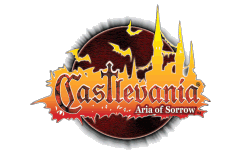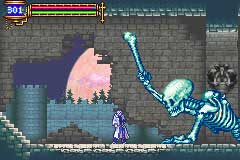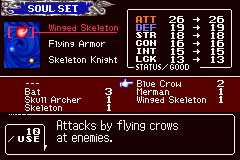 |
Castlevania: Aria of Sorrow - Review
|  |
Aria of Succession
By: Solon
| Review Breakdown | | Battle System |
7
| | Interface |
6
| | Music & Sound |
8
| | Originality |
5
| | Story & Plot |
5
| | Localization |
6
| | Replay Value |
6
| | Visuals |
8
| | Difficulty |
Moderate
| | Completion Time |
6-15 Hours
| | | Overall |

|
 | |
Insert Japanese scream here |
|

|
Yet another Castlevania title, Castlevania: Aria of Sorrow, has been released for the GBA. This one might have been the most awaited, or at least it was for me. While the previous title (Harmony of Dissonance) didn't quite satisfy me, this title really was something great. Not greater than Symphony of the Night for the PlayStation, but far greater than Circle of the Moon. The year is 2035. You are Soma Cruz, a young student which suddenly is dragged into a fierce battle with the endless Darkness. The plot is just like in all other Castlevania games: simple and fun. There are hardly any plot twists or long conversations, but then again that's how it has always been in these games. It would've felt weird if the dialogue would've taken over, because those who play Castlevania want endless action.
What's more important to talk about though is the battle system. While the whole setup is the same as in all other (except the N64 title) Castlevania games, there are some parts that make this game stand out. Soma uses a sword rather than a whip, just like Alucard in Symphony of the Night, a character which also actually appear in Aria of Sorrow. Weapons and equip can be found almost anywhere in the game, and some of them are very hard to find. However, it was the different skills that brought my attention to the game. When you defeat an enemy, there is a slight chance that its soul will pop out of the dead body and fly right into Soma. This is his secret power; he receives the souls of the dead and makes use of them, learning flashy abilities. Very cool indeed, and as almost every enemy in the entire game has the ability to drop his or her soul, this will make the game both longer and more fun. At some places, it's almost a must to stay behind for a while and collect the souls of the enemies, as they are of great help in the future areas of the game.
There are 3 slots to set up your collected souls on. The first slot is mostly attack spells, while the other slot uses spells or abilities that are useful for traveling or making your way through difficult surroundings. The third slot is mostly for support, for example some souls might give you a Strength boost of 8, or a Intelligence boost of 4, stuff like that.
 | |
You may be bigger, but I'm stronger |
There's more to the battle system as well, some of the older skills are found lying around. For example, Soma sooner or later has the ability to do a double jump (jump once more when in the air, for those who are unfamiliar with this skill), dash backwards, turn into a bat etc. This is by far one of the most enjoyable Castlevania Battle Systems seen this far, and in my opinion, only Symphony of the Night surpassed this.
This is combined with an interface that feels somewhat okay. It looks almost exactly the same as the other Castlevania games for the GBA, so there really isn't much to say about it. There's the ordinary, item, equip, ability etc. and the Soul Set with 3 slots which I explained earlier. It's not better than the older titles, but then again it's not worse either.
What was far better than the older titles though, was the music. While Harmony of Dissonance probably had the worst Castlevania soundtrack ever, Konami knew they couldn't make the same mistake again. The music is spectacular, every song has a perfect feeling, and it fits well into the game at all times. There were hardly any songs that I didn't like. I must say that I am surprised over how well the GBA manages to handle sounds.
Perhaps the weakest part of most Castlevania games used to be both localization and originality. Most Castlevania games are basically the same, destroy Dracula or prevent him from being reborn (again). Battles and areas are the same; some of the bosses appear in many of the games (Death for example). But then again, this is some sort of tradition; a Castlevania without these things wouldn't become a real Castlevania, sort of.
 | |
The Soul Set System... |
In regards to the localization, it was far better in Aria of Sorrow than it has ever been. While the older titles managed to include some really weird sentences, Aria of Sorrow has a decent flow in the dialogue. There was also a lot more conversations in this title than in the previous, and Soma meets new people all the time when running through the incredibly large castle.
As I stated above, the looks of this game are utterly cool. It's a lot smoother and more beautiful than the other Castlevania games in my opinion, and also a lot faster. Anyway, the replay value goes quite low, as usual. The only reason to play this game once more is to play as another character (you can, by putting in another name in the beginning, just like in Symphony of the Night). Otherwise, there is nothing to return to, other than experiencing the same story again. However, if you manage to get the special ending, there are some other things you can do after clearing it. There is Boss Rush (you meet several bosses in a row), and you can listen to the tunes and sounds in the game. Sort of like a bonus for clearing the real difficult part of the game. The main scenario isn't that difficult. It can be really frustrating sometimes, especially with some of the bosses, but this game isn't anything you'll put away because if the difficulty. It's rather short, but that's no news in the world of Castlevania. It can be completed anywhere between 6 to 15 hours.
I loved Castlevania: Aria of Sorrow. I consider it one of the best Castlevania games ever released, and I hope that future titles will be as lovely as this one.
|







